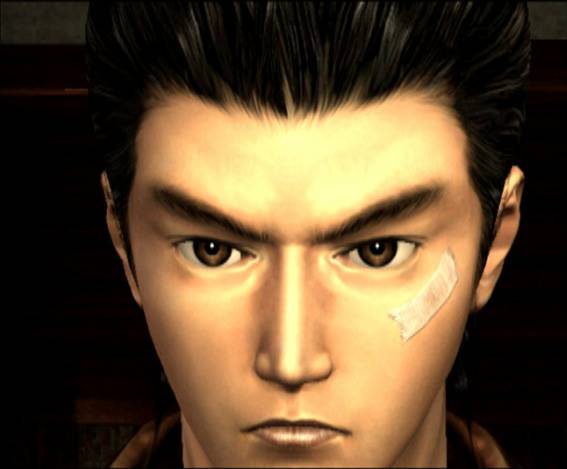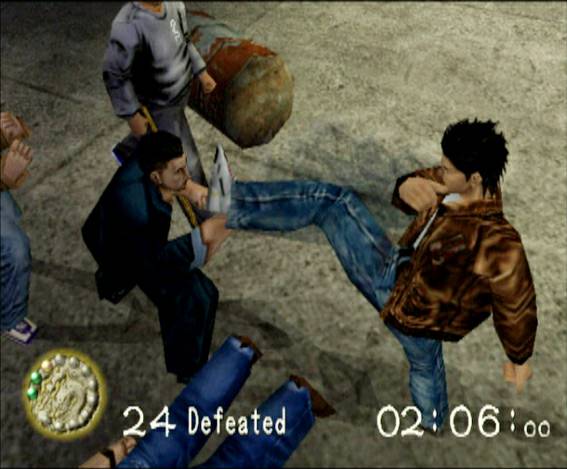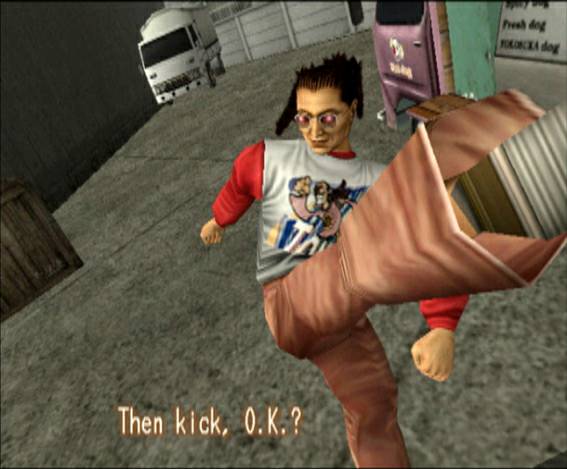Shenmue
Review - possibly the greatest RPG of all time

Suzuki's Gift
Easily one of the most anticipated games of the past few years, Shenmue is the brainchild of one Yu Suzuki - the man who is considered in some circles to be, alongside Sonic creator Yuji Naka, the best game designer currently working at Sega. Currently the head of Sega's AM2 division, Suzuki has been an innovator in the field of 3D gaming for years - producing games such as Space Harrier and Virtua Fighter, which may seem dated now but were groundbreaking in their time. Since the original announcement of Shenmue, every release of images has astounded and thrilled even the most cynical journalists and the most battle-weary console fans with their beautifully realistic depiction of characters and locations - giving meaning, arguably for the first time, to the whole concept of a "next generation" console. Shenmue promised something that no game had ever before even dared to hint at - a fully interactive world, which lives and breathes around you as you play, and in which you can interact with anything and anyone. Believers have enthused about the enormous potential of this for months; sceptics have explained over and over why this is an impossible task. With Shenmue finally on the shop shelves, the question of whether the game lives up to its own hype can be answered at last - as well as the burning question of whether it can justifiably be considered to be the start of a whole new genre, as Yu Suzuki has claimed so many times.

Brave New World
The first thing that will strike anyone about Shenmue, unsurprisingly enough, is the graphical splendour of the game. A short intro features a young girl standing on top of a cliff delivering a monologue, while the camera swings and pans around her, following the flight of a beautifully detailed bird of prey before zooming in dramatically to a close-up of her flawless face. This scene alone outshines the quality of anything seen to date from a console game, coming startlingly close to the standard of FMV seen in the likes of Final Fantasy VIII, and this standard of graphics is perpetuated throughout the entire game. If you gasped when you first came across Hyrule Field in Zelda 64, Shenmue will have you doing a convincing impression of a fish out of water for most of the time spent playing it; from countryside roads to bustling towns, villages and dockyards, the game constantly astounds the player with both its depth of vision and of detail at once. Perhaps more impressive than the environments are the characters themselves. Central characters such as Ryo himself are modelled with painstaking care, right down to having moving eyeballs, eyelids and lips - meaning that scripted scenes can use a whole range of facial expressions and movements. Many of the scripted scenes, fight sequences in particular, are very impressively animated, and extensive use is made of motion blur and slow-motion to create martial arts effects which wouldn't look out of place in a good kung-fu film. However, the animation of the characters outside of the scripted scenes can be disappointing - Ryo himself seems to shuffle about like someone with a gammy leg much of the time, and other characters can seem very stiff in their movements, which does let down the otherwise unprecedented graphical look and feel of the game world.

Swept Along
It's all very well to create an astounding-looking game world, but allowing the player to interact with it in a meaningful way is a much more difficult thing to achieve. The basic plot of Shenmue is quite simple - a sinister intruder murders Ryos father in the opening moments of the game, and it is up to Ryo to avenge his death. First of all, of course, you need to find out who it was that killed him, which leads you off on a chase around the nearby villages and towns that would make Agatha Christie proud. This element of the game is somewhat disappointing, in fact; Ryo spends hours walking around asking people if they've seen a black car, following up dead-end leads and only very gradually finding out any new information about his fathers killer. This can become very tedious indeed if you're actually playing through the game as a straightforward RPG-style affair; Ryo wakes up in the morning, walks into town, and asks the same questions over and over again, night falls and he goes home - lather, rinse, repeat. Most of all, this ruins the impression of freedom in the game. You don't have a choice as to the line of inquiry you follow; Ryo asks about the car, and from there the path of questioning and progress which you will follow in the plot is totally set in stone. This is understandable - after all, the amount of dialogue which would need to be recorded in order for multiple plot paths to be available is ridiculously large - but disappointing nonetheless. After all, with all the effort that has gone into making Shenmue into a genuine, living, breathing virtual world, forcing the player to take a specific path through it seems a bit of a letdown.

Interact, Interact, Interact
There is one saving grace to the rigid plot of the game, however, and that is the freedom which the game gives you to explore the world outside the boundaries of the storyline. While your ultimate mission in the game is to find out who killed your father, and avenge his death, Ryo doesn't have to be single-minded in achieving this goal. Along the way there is plenty of opportunity to have fun in the game world - looking after a stray kitten, collecting toys from vending machines and racking up high-scores on arcade-perfect Hang On and Space Harrier machines are only a few of the things which Ryo can sidetracked doing. Every person you see on the streets of the town has a real life as well - it's possible to follow someone around for an entire day, see where they live, where they work and even where they eat lunch. Shenmue does grant the player freedom to interact with their surroundings - right down to having a poke through the drawers in Ryo's house, or picking up items in a shop to examine them up close - that is unprecedented in gaming, and this makes it impossible to compare it to any other type of game. Considered as an RPG or adventure game, Shenmue is a very poor example; but the addition of a real, persistent game world adds so much breadth (if not depth) to the title that it is unfair to put it alongside the likes of Final Fantasy or its ilk. The limitations which apply to your progression through the story pale in comparison to your freedom to do whatever you like outside the storyline, making Shenmue into a game which is not so much "played", as "experienced", and justifying Yu Suzuki's claim to have created a whole new genre.
Conclusion
Like the real life that it tries so hard to emulate, you only get from Shenmue whatever it is that you put into it. If you stick rigidly to the plot and try to get to the end of the game in a hurry, you will be shockingly disappointed (not least because this is only the first chapter of a much longer saga, so the story is not wrapped up at the end) by the game; but if you take the time to explore, and allow yourself to be sidetracked by the wonders of the world of Shenmue, you'll experience one of the most compelling and unusual gaming experiences ever created. While this is certainly not the last word in gaming which some enthusiasts had hoped for, it may well be the first word in a whole new page in videogaming history.








